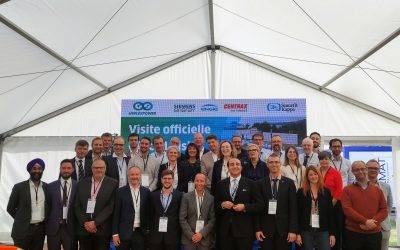Conceptual proof for fuselage wake-filling propulsion integration completed
One step closer to climate-neutral aviation:
International research team completes the conceptual proof for fuselage wake-filling propulsion integration
The so-called Propulsive Fuselage Concept (PFC) has the potential to play a key role in developing more efficient and less polluting airplanes of the future. The turbo-electric PFC aircraft for 340 passengers produces 4.7% less CO2 emissions compared to an equally advanced conventional aircraft. In addition to the two gas turbines on the wings, an electric fan is located at the aft-fuselage to produce thrust by ingesting and re-energising the airflow around the fuselage. The PFC configuration features excellent compatibility with other advanced technologies including hydrogen fuel technology. After 3.5 years of research, the consortium of the European-funded CENTRELINE project has managed to complete the proof of concept and experimental validation for this highly promising technology thereby maturing it to Technology Readiness Level (TRL) 3 and bringing it closer to a possible industrial uptake in the future.
Munich, 3 August 2021: The European Green Deal seeks to achieve a 90% reduction in transport emissions by 2050. This is a huge challenge for aviation requiring cutting-edge new technologies and innovations to make this happen. In enabling aviation’s long-term sustainability, novel propulsion technology and propulsion-airframe integration play a key role. A yet untapped source of further efficiency improvements is associated with fuselage wake-filling propulsion integration, i.e., the ingestion and re-energisation of the fuselage boundary layer flow by the propulsion system. The positive effect of “wake-filling” on propulsive power requirements has long been known from the field of marine propulsion. Ship propellers are typically located at the aft body of the vessel and operated within the boundary layer flow close to the ship’s body surface. This physical principle is also applicable to airborne propulsion, as the 11 CENTRELINE partners of six European countries have just proven. In this recently published “Propulsive Fuselage Aircraft” animation video, the team of leading research and industrial stakeholders show their vision of how to fly in 2035.
Project results form an important building block on the way we may be flying in 2035 and beyond
“We have successfully tackled the immediate challenges that are associated with fuselage wake-filling propulsion integration. With the proof of concept performed in CENTRELINE, we have lifted this cutting-edge technology to the next level. Our achievement may represent an important steppingstone on the way to preparing “Propulsive Fuselage” technology for a possible aircraft product development in the future”, says project coordinator Arne Seitz of Bauhaus Luftfahrt e.V. “In order to support any follow-on research and innovation activities, we have devised a roadmap for the PFC aircraft technology towards TRL 6 by the year 2030. As a further enhancement of its innovative potential, we have identified a set of further advanced technologies that feature excellent compatibility with the PFC aircraft configuration. All this was enabled by a great collaborative spirit and excellent individual contributions from the partners in the project.”
The scientific and technological development outcomes from CENTRELINE are highly relevant for follow-on research and innovation activities. This is the result of the methodological advancements and systems design knowledge developed as well as due to the synergistic compatibility of fuselage wake-filling propulsion integration with other promising technologies, such as revolutionary core engines (such as the Composite cycle Engine, CCE), High-Temperature Superconducting (HTS) technology, ultra-efficient wing technologies (such as Natural Laminar Flow, NLF, wings as demonstrated by the BLADE demonstrator in Clean Sky, and, liquid hydrogen (LH2) fuel technology.
Propulsion Fuselage Concept leads to cleaner long-distance flights
The CENTRELINE partners maximised the benefits of aft-fuselage wake-filling under realistic systems design and operating conditions. A thorough understanding of the aerodynamic effects of 360° fuselage boundary layer ingestion was developed through extensive aero-numerical simulations and low-speed wind tunnel and fan rig testing. All detailed design and analysis results were incorporated in a multi-disciplinary aircraft family pre-design and the PFC technology was rigorously benchmarked against a similarly advanced but conventional aircraft. The evaluation was performed for the impactful mid-to-long range air transport task featuring 340 passengers and 6500 nmi (~12,000 km) design range in the year 2035. It shows -4.7% CO2 for the turbo-electric PFC against the advanced reference aircraft or -36% relative to a year 2000 baseline. PFC NOx (Nitrogen Oxides) emissions during the ICAO Landing and Take-off (LTO) cycle are reduced by 1.8% relative to the year 2035 reference, and by 41% compared to the year 2000 baseline. During cruise (high-level), the PFC aircraft may cut NOx emissions by 20% and 64% against year 2035 and 2000 standards, respectively.
High-quality research outputs are paving the way towards TRL 6
During the 3.5-year programme, the CENTRELINE consortium has formed a strong team of leading research and industrial stakeholders supporting Europe’s leading position in aviation. Several PhD researchers have worked on topics of high interest to the aeronautical community and CENTRELINE partners disseminated their results in several scientific journals. A Policy Maker Workshop was organized (Brussels, 2019) and dedicated CENTRELINE sessions have been held at ISABE and EASN conferences (2019). At the EC Aerodays (Bucharest, 2019) the wind tunnel model and a section of the fuselage fan blading were displayed. Public project reports documenting the detailed technical results can be downloaded from the CENTRELINE project website. CENTRELINE’s PFC technology was also featured in broadcasts by euronews and BBC. A joint journal article prepared by the consortium summarises the final project results and can be openly assessed under the following link: https://doi.org/10.3390/aerospace8010016.
CENTRELINE background
The CENTRELINE project stands for “ConcEpt validatioN sTudy foR fusElage wake-filLIng propulsioN intEgration” and was funded with 3.7 million euros by the European Union under the Horizon 2020 framework programme. Coordinated by Bauhaus Luftfahrt, the CENTRELINE project consortium comprised 11 partners from six European countries. Beside Bauhaus Luftfahrt, these included four leading industry partners, namely Airbus Defence and Space, Airbus Operations, MTU Aero Engines, Rolls-Royce and Siemens, as well as four reputable European universities, namely Chalmers University of Technology, Delft University of Technology, the University of Cambridge and Warsaw University of Technology, supported by the management consulting partners ARTTIC Innovation GmbH and ARTTIC SAS. The CENTRELINE consortium was accompanied by a technical advisory board of experts from industrial stakeholders and research organisations.
Press Contact:
Verena von Scharfenberg
ARTTIC Innovation GmbH
scharfenberg@arttic-innovation.de
Project Contact:
Dr. Arne Seitz, Project Coordinator
Bauhaus Luftfahrt
arne.seitz@bauhaus-luftfahrt.net
This project has received funding from the European Union’s Horizon 2020 research and innovation programme under grant agreement No 723242 .
Why the carousel of amendments to the R&D tax credit law continues to turn
The R&D tax credits in 2024The year 2024 has proven to be decisive for the German R&D tax credits. Following the most recent amendment as part of the Growth Opportunities Act in March, the Federal Government realized during the budget consultations for 2025...
Register Now: In Conversation with EBiSC2
Unlocking the Potential of Stem Cells: Discover the EBiSC Journey to SustainabilityJoin the conversation on the initiative that’s shaping the future of biomedical research! On May 15, 2024, from 14:15 to 15:00 CEST (Europe/Brussels time), the Innovative Health...
The R&D tax credit with a blind eye to earnings –
Why loss-making companies (wrongly) hesitate
Recapitulation The German R&D tax credit has become much more popular in recent years after a modest response following the introduction of the instrument. This can be seen not only in advertising and studies by various associations, but also in the bare figures...
Junior Funding Consultant (m/f/d)
We offer you the unique opportunity to become part of a successful & young team in the attractive growth market for tax-incentivised research funding (R&D tax credits). We are looking for Junior Funding Consultants with a passion for innovation, scientific...
First successful demonstration with 100% green H2
HYFLEXPOWER celebrates successful operation of a gas turbine with 100% green H2On October 12, 2023, at a public event hosted at the HYFLEXPOWER demonstrator site in Saillat-sur-Vienne, France, the HYFLEXPOWER consortium unveiled a ground-breaking achievement - the...
New Security Project AGILE Will Improve Disaster Risk Management
New international security project to improve disaster risk management for unexpected eventsThe international security project AGILE will kick start today. The project is to develop novel tools and methodologies for understanding, anticipating, and managing High...
SYNERGISE for Improved Disaster Management
Internationally Funded Project to Develop an Integrated Toolkit for Improved Management of Natural and Man-Made Disasters Kicks-Off TodayTo boost the efficiency and safety of first responders during life-saving missions, the SYNERGISE team will develop a Novel...
Junior Innovation Consultant (m/f/d)
We offer you the unique opportunity to become part of a dynamic team in the attractive field of innovation and research. We are looking for Innovation Consultants with a passion for innovation, scientific writing and project management. This position is for recent...
Senior Innovation Consultant (m/f/d)
We offer you the unique opportunity to become part of a dynamic team in the attractive field of innovation and research. We are looking for specialists with a passion for innovation, scientific writing and project management. This position is for experienced...
Business Developer (m/f/d)
We are looking for specialists in business development with a strong sales talent and an interest in innovation, research and science. This position is for recent graduates or experienced professionals and involves assisting clients from a variety of industries with...










